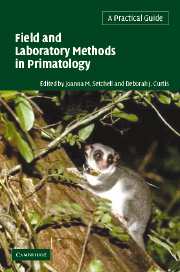Book contents
- Frontmatter
- Contents
- List of contributors
- Forword by Robert D. Martin
- Introduction
- 1 Human-nonhuman primate interactions: an ethnoprimatological approach
- 2 Habituating primates: processes, techniques, variables and ethics
- 3 Habitat description and phenology
- 4 The Global Positioning System, Geographical Information Systems and Remote Sensing
- 5 Monitoring local weather and climate
- 6 Survey and census methods: population distribution and density
- 7 Trapping primates
- 8 Handling, anaesthesia, health evaluation and biological sampling
- 9 Morphology, morphometrics and taxonomy
- 10 Marking and radio-tracking primates
- 11 Feeding ecology and seed dispersal
- 12 Dietary analysis I: Food physics
- 13 Dietary analysis II: Food chemistry
- 14 Collecting arthropods and arthropod remains for primate studies
- 15 Tape-recording primate vocalisations
- 16 Photography and video for field researchers
- 17 Chronobiological aspects of primate research
- 18 Thermoregulation and energetics
- 19 Field endocrinology: monitoring hormonal changes in free-ranging primates
- 20 Collection, storage and analysis of non-invasive genetic material in primate biology
- 21 Tips from the bush: an A-Z of suggestions for successful fieldwork
- Index
- References
2 - Habituating primates: processes, techniques, variables and ethics
Published online by Cambridge University Press: 05 June 2012
- Frontmatter
- Contents
- List of contributors
- Forword by Robert D. Martin
- Introduction
- 1 Human-nonhuman primate interactions: an ethnoprimatological approach
- 2 Habituating primates: processes, techniques, variables and ethics
- 3 Habitat description and phenology
- 4 The Global Positioning System, Geographical Information Systems and Remote Sensing
- 5 Monitoring local weather and climate
- 6 Survey and census methods: population distribution and density
- 7 Trapping primates
- 8 Handling, anaesthesia, health evaluation and biological sampling
- 9 Morphology, morphometrics and taxonomy
- 10 Marking and radio-tracking primates
- 11 Feeding ecology and seed dispersal
- 12 Dietary analysis I: Food physics
- 13 Dietary analysis II: Food chemistry
- 14 Collecting arthropods and arthropod remains for primate studies
- 15 Tape-recording primate vocalisations
- 16 Photography and video for field researchers
- 17 Chronobiological aspects of primate research
- 18 Thermoregulation and energetics
- 19 Field endocrinology: monitoring hormonal changes in free-ranging primates
- 20 Collection, storage and analysis of non-invasive genetic material in primate biology
- 21 Tips from the bush: an A-Z of suggestions for successful fieldwork
- Index
- References
Summary
INTRODUCTION
Field biologists adopted the term habituation from physiology, as the relatively persistent waning of a response as a result of repeated stimulation that is not followed by any kind of reinforcement (Thorpe, 1963). Repeated neutral contacts between non-human primates (hereafter called primates in this chapter) and humans can lead to a reduction in fear, and ultimately to the ignoring of an observer. The techniques and processes involved have only rarely been described (e.g. Schaller, 1963; Kummer, 1995), as habituation has generally been viewed as a means to an end (Tutin & Fernandez, 1991). The few studies that have quantified primate behaviour in relation to habituators describe the process with African great apes (Grieser Johns, 1996; van Krunkelsven et al., 1999; Blom et al., 2001). As we become increasingly aware of the potential effects of observer presence on primate behaviour, and especially the potential risks of close proximity with humans, it behoves us to measure as much as possible about the habituation process.
Many behavioural responses are taxon specific, and these should be taken into account when one is trying to habituate human-naïve wild primates. Between us we have had experience with a wide range of wild primates, ranging in size from marmosets (Callithrix spp.) to gorillas (Gorilla spp.), from South America, Africa, Madagascar and Asia, which, together with discussions with colleagues, we have used to make this chapter as broadly applicable as possible.
Information
- Type
- Chapter
- Information
- Field and Laboratory Methods in PrimatologyA Practical Guide, pp. 25 - 39Publisher: Cambridge University PressPrint publication year: 2003
References
Accessibility standard: Unknown
Why this information is here
This section outlines the accessibility features of this content - including support for screen readers, full keyboard navigation and high-contrast display options. This may not be relevant for you.Accessibility Information
- 47
- Cited by
